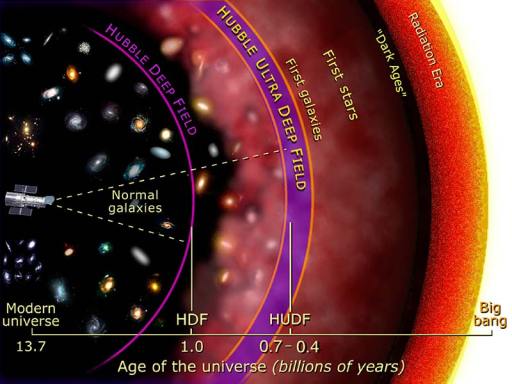The FLWR Cosmological Model
The basic mathematical model of cosmology is the FLWR model which is the very simple model resulting from Einstein’s equations assuming the validity of the Cosmological Principle (CP) stating that the Universe on large scales is
- isotropic (the same in all directions)
- homogeneous (the same at all locations)
- Not only the laws of nature, but also the events occurring in nature, the World itself, must appear the same to all observers, wherever they may be.
The FLWR model can alternatively be viewed to express conservation of energy and momentum in Newtonian mechanics in the form of a simple system of ordinary differential equations in the density and the scale factor
as functions of time
. Here the scale factor connects physical coordinates
to reference coordinates
by
and
can be viewed as an expansion factor of space itself changing the distance between objects over time.
Hubble’s Law
The Hubble parameter depending on
is defined by
, where
, and couples velocity
to distance
by Hubble’s Law
The FLWR model takes the following form in the case if a flat Universe with zero pressure:
(Friedman’s equation = conservation of kinetic + potential energy)
(conservation of mass)
where is the gravitational constant and
the total mass of the University which is constant in time. This system is readily solved to give assuming
and
at present time
:
.
We see that decays like
as
increases.
Validity of CP
We see that CP gives a very simple solution to Einstein’s equations, or equivalently to Newton’s equations, and one may ask if in the spirit of Einstein if it is too simple? How realistic is CP?
The question is discussed in What Is the Principal Evidence of CP? without much of a definite answer.
But from a mathematical point of view the CP assumption of homogeneity is very strange since it leads to a model without space dependence. More precisely, the idea of expansion initiated as a Big Bang in the FLWR model expresses non-homogeneity since Big Bang is viewed as a phenomenon somehow localized in space. We thus face a contradiction between non-homogeneous initial data and homogeneous solution. It seems that the contradiction is either ignored or waved away with the usual argument this is an aspect of relativity theory beyond human understanding.
But the fact remains that the 2011 Nobel Prize in Physics was awarded observations that the above simple model does not fit with reality. If Einstein had been alive he would have said that is not strange because the model is simply too simple. What do you say, does this look homogeneous (follow up in How to Get a Nobel Prize):
Note that even if at a given time instant the Universe would be homogeneous, observations with time delay would give the impression of non-homogeneity as in the above picture.

